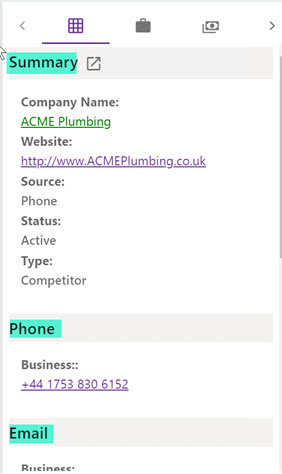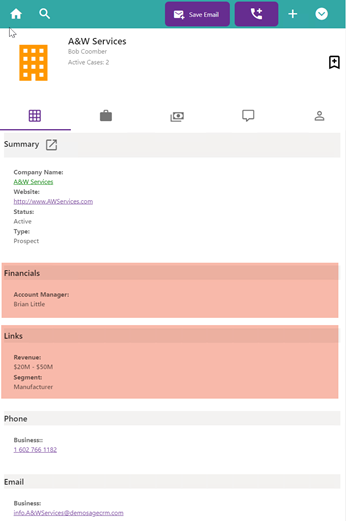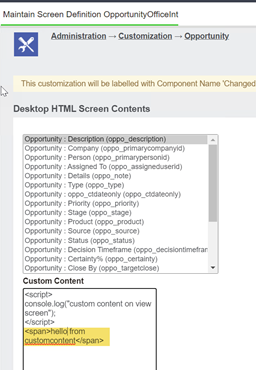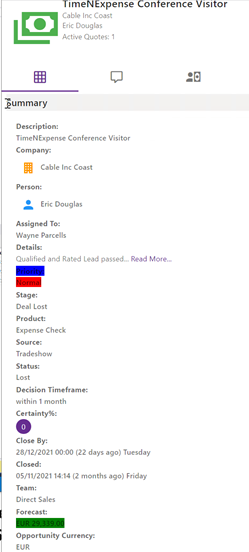Summary Screens
Summary screens show a top area with an icon and some data.
At a glance, a user will be able to see the state of an entity.
- Note: Empty fields will not display on the screen.
Company and person summary for example shows the title plus the communications count in the last year and the open opportunities and cases.
The entity icon is on the left of the screen.
The information is in the center and on the right of the screen we have the option to toggle the bookmark.
Below this area we have the tabs.
Hover your mouse over the icon to see the caption. If the tabs are too many you will see the <> icons to navigate across.
Screens are made up of sections. Section fields are usually controlled from CRM via the
ENTITYofficeint
screen. If using a custom entity you will have to create this screen. The exception is the Phone, Email and Address screens.
Links
Text links (usually in green) will open full CRM in a new tab.
Images usually navigate within the task pane. The exception is the "External" link icon which can be seen in the section header.
Note that "external" links replace the Sage CRM webservice SID with the one that is active in the live CRM. Users need to log into Sage CRM in their default browser. This is required to work with the Sage CRM security settings (IP address checking and Browser sessionsecurity)
- This can be turned off by adding in a new value to the custompages/sagecrmws/web.config called "securityoff" and the value set to "true". You also then need to disable the Sage CRM security settings (IP address checking and Browser sessionsecurity).
Customizing
A. The Summary screen is in the format
ENTITYOfficeInt
and can be edited in CRM.
On the Company summary screen the phone and email display all values.
For the person section, you can edit this using the screen
PersonOfficeIntSmall
in CRM.
B. Customising Top Content
When including a custom entity by default only the field
prefix_name
will be shown. You can control this area though by creating a screen in CRM on the entity in the format
ENTITYOfficeIntTop
and up to the first 3 fields (only) will be displayed.
EG
and this is how it would look
C. You can create sections on your summary screen but creating a screen in the format
ENTITYOfficeIntN
Where N is a number. The value in N starts at 1 and must continue in values of 1.
For Example you might want to display ERP fields in an ERP section on a company so you would create a screen called "CompanyOfficeInt1". The "Screen Caption" is also used as the header. You add in whatever fields you want there.
If you then also wanted to create a section with SLA data you could then create a screen called "CompanyOfficeInt2" and you add whatever fields you want in that.
Screens in CRM
Screens in Accelerator
D. Custom Content support
This is included now on the bottom of the screen (section in the Accelerator UI).
Please note. If you had a script like this (below) that has a button that has a click event you must put in a pointer at the global level. EG
window.globalmethodname= methodname;
EG
<script>
function sayHi(sender) {
alert('Hello '+sender);
}
setTimeout(sayHi, 1000, 'bob');
window.sayHi= sayHi;
</script>
<button onclick="sayHi('frank')">push me</button>
E. Create Scripts These can now we used to change the colours on the display of the AC screens.
The styles for the field "caption" and "value" can be set using
- ValueStyle
- CaptionStyle
EG
ValueStyle='background-color:red'; CaptionStyle='background-color:blue';
The field value can also be accessed
EG
if (Value.amount>20) ValueStyle='background-color:green'; else ValueStyle='background-color:blue';
Example of how the screen would look









